Frederick Jones, in his 1946 book "The Glory that was Bristol" lists some of the structures that survived until very recent times...
In 1927, whilst excavating Castle Street near Castle Green, a four foot diameter shaft was discovered. This led into another passage that led to the river and is supposed to have been part of the drainage system of the castle. other passages have also been discovered under Castle Green.
A room was found where the north wall of the castle stood. This was used as an air raid shelter in the 1940s.
At the junction of what was Cock and Bottle Lane and Castle Green to the north of the castle was an oval underground room. This was filled with cement during redevelopment work in 1937.
One of the castle wall's bastion towers stood in Castle Street until it was demolished in 1927. This tower was built of sandstone and rubble, stood thirty feet high, had walls 3 feet thick and contained traces of a spiral staircase.
Another tower stood in Holmes Place, just off of Castle Street. This tower still had part of the castle's 30foot walls still attached to it. This was near the supposed site of the castles banquet chambers. It was demolished in 1937.
An early 17th century building, Tower House in Tower Street was partly demolished in 1937 as part of redevelopment work, then totally destroyed in an air raid during WWII. This seems to have formed part of a quadrangle containing the Chapel of St. Edward with a portico into the banquet hall and palace. The first of these buildings was approximately 23 feet by 16 feet and had a roof of groined ribs. The second was accepted as a thirteen century addition to the banquet hall and contained an 8ft. by 8 ft. Norman Arch. There was also a vestibule, 24ft. by. 14ft. by 13ft. that also contained a groined ribbed roof. The roof was supported by a series of wall columns.
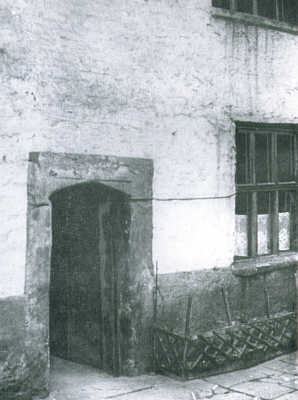
Tudor building in Tower Street - demolished 1939
This may have been built on the site of the castle's banquet hall.
Photograph by Owen A. Webb
From "The Glory that was Bristol" by Frederick C. Jones (St. Stephen's Press, 1946, page 20)
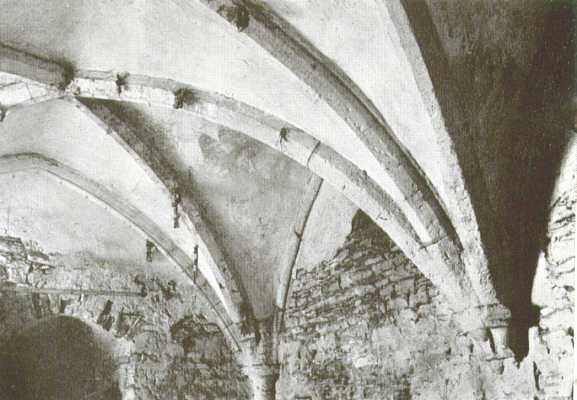
This roof in Tower Street survived until at least 1958 when Reece Winstone wrote the first edition of Bristol Today
Image from "Bristol Today" by Reece Winstone, (2nd Edition, 1963, plate 24)
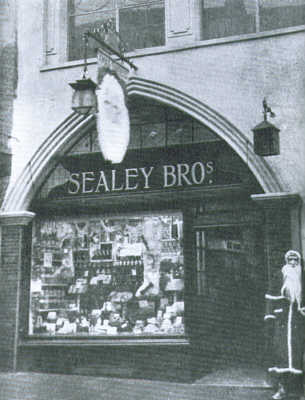
21 Tower Street - December 1920
Porch to the castle banquet hall
Image from "Bristol in the 1920's" by Reece Winstone, (1971, plate 41)
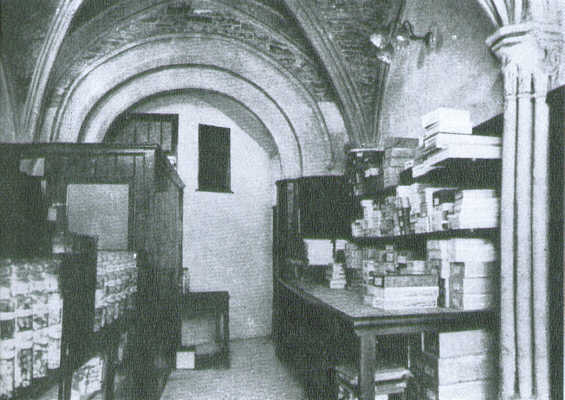
21 Tower Street (interior) - 1920
Porch to the castle banquet hall
Image from "Bristol in the 1920's" by Reece Winstone, (1971, plate 46)
The original notes for photographs 24 and 41 says that these fragments survived the blitz, but there is a note with photo 46 that says that Boots Ltd. took over this building in the 1930's and it was bombed in the 1940's, which seemed to contradictory. Andy Foyle kindly emailed in February 2006 and explained that "The shop was Boots the Chemist in the 1930s, it was bombed in 1940 or 41 and only partially destroyed. The two roofed chambers survived, and still do. They were given a brick 'shell' and glass fronts in the two arches one of which is shown as Sealey's in the 1930s photo. In the 1970s they were tarted up rather badly and reopened as a restaurant, but it closed by the 1980s I
think. They are now empty but you can still look through the glass fronts and see the medieval vaults and columns, and the Norman arch at the back."
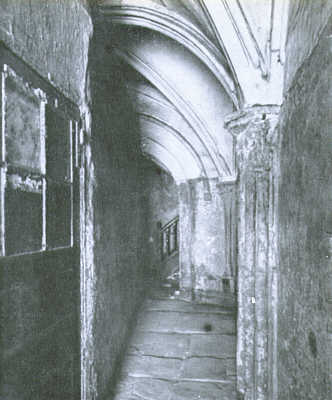
Tower Street
Vestibule and Norman Arch Leading to the Banquet Hall
Parts of this structure survived the blitz and some of the staircase in the centre of the image still survives in the care Bristol Museum.
Image from "Bristol in the 1880's" by Reece Winstone, (2nd Ed. 1978, plate 23)
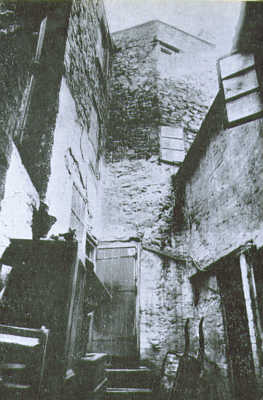
Octagonal tower at 21 Castle Street
This was demolished in the 1920's
Image from "Bristol in the 1880's" by Reece Winstone, (2nd Ed. 1978, plate 24)
Today
Nothing much survives from what was once one of the biggest castles in the land. There are no collections of furniture, arms, armour, treasure or tapestries. No real ruins to walk around and wonder at. The ancient foundations on Castle Green, could, if the truth be told, be the remains of almost anything. They only hint at the huge building that stood for around 600 years.
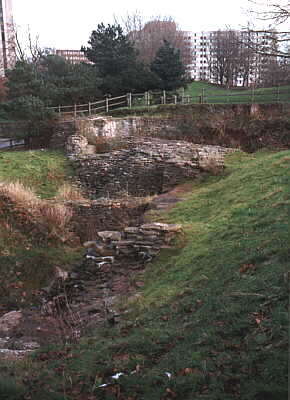
The remains of Bristol Castle - 1999
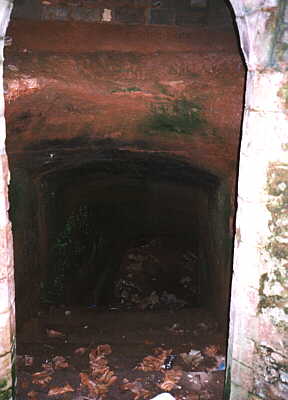
Castle entrance to the Sallyport - 1999
The sallyport led down to the moat where defenders could attack anyone trying to undermine the castle walls.
Part of the vaulted chambers still survive in one of the buildings in Tower Street and Bristol Museum has some interesting pieces in storage. In the centre of the image "Tower Street
Vestibule and Norman Arch Leading to the Banquet Hall" above you can see part of a staircase. The staircase is mid-17th century and may have been installed when the castle was modernised in preparation for the Civil War. It survived the blitz and part of it was re-installed in a 1970s' restaurant. When the restaurant closed around the end of that decade it was taken to Bristol Museum where it is now presumably in storage. Andy Foyle says that "I unpacked it for the first time when I worked there in 2001. It is pretty much in pieces and full of worm, but we did what we could to conserve it.
Another piece that survives in the care of the Bristol Museum, Andy Foyle describes it as a "plaster ceiling with an oval panel bearing the Royal arms and initials CR, presumably for Charles I rather than Charles II. It must also have been installed probably in the Constable's house or some other important chamber around the time of the Civil War. The parts of the castle that survived the demolition of 1655-6 included that ceiling. It remained as a house on Castle Green, which by 1910 was a factory making oil paints. It was demolished in that year but the ceiling was taken down in one piece and given to the museum."
Sources
A special thank you to Andy Foyle who very kindly informed me of the pieces now in the care of Bristol Museum and so encouraged me to update these pages.
As usual I've used many sources for this work, these are listed below. Where I've only taken one or two facts from a site or book the source is also given in the text.
A Chronological Outline of the History of Bristol by John Evans (Bristol Observer, 1824)
Accounts of the Constables of Bristol Castle in the Thirteenth and Early Fourteenth Centuries by Margaret Sharp (Bristol Record Society's Publications, 1982)
Bristol Castle: A Political History by Peter Fleming (Bristol Historical Association, 2004)
Bristol, England - City of a Thousand Years by H. G. Brown and P. J. Harris (Burleigh, 1979)
Bristol in Old Photographs by Della Moorcroft and Neil Campbell-Sharp (Sutton, 1988)
Bristol Past and Present by J. F. Nicholls and John Taylor (Arrowsmith, 1881)
Bristol in the 1880's by Reece Winstone (2nd Ed. 1978)
Bristol in the 1920's by Reece Winstone (1971)
Bristol Today by Reece Winstone (2nd Ed. 1963)
Caen Stone - Stone from Caen, France was used to build the Castle's Keep
Calendar of the Charters of the City and County of Bristol by John Latimer (W. C. Hemmons, 1909) - The charters detailed on these pages come from this work.
For King & Parliament - Bristol and the Civil War by John Lynch (Sutton, 1999)
Geoffrey de Montbray
Guibon Goddard's Journal - reports of Parliament, November 1654
History of Bristol Castle (Internet Archive)
Jacob's Well, Bristol: Mikveh or Bet Tohorah? by Joe Hillaby and Richard Sermon
Our Family History - A fantastic piece of work - the genealogical survey of the peerage of Britain.
Sir Williem Le Scrope, K.G.
St. Mary the Less, Cambridgeshire
The Bristol Mint - An Historical Outline by L. V. Grinsell (Bristol Branch of the Historical Association) - Most of the information about the mint came from this booklet.
The Glory that was Bristol by Frederick C. Jones (St. Stephen's Press, 1946) - The book contains an interesting early description of the castle as well as a survey of the surviving buildings at the end of WWII.
The Story of Old Bristol by E. M. Habgood (Industrial Art/Dolphin Publicity, 1966, 2nd Ed.)
This page created April 8, 2005; last modified November 6, 2022







